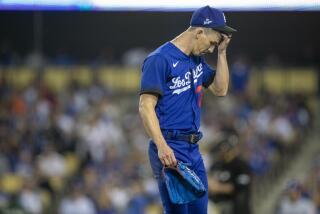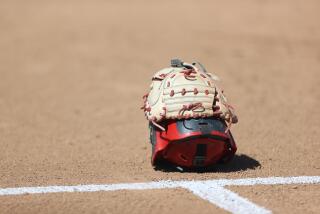Safe at the plate
- Share via
The 10-year-old boy was sliding into second base last fall during a Little League game when a thrown ball hit him squarely in the mouth, knocking out two front teeth.
The frightening incident in Half Moon Bay prompted impassioned pleas from parents to add face guards to batting helmets. The Northern California city faced a decision similar to one being debated in communities across the country: Should youth baseball be made safer? Or should these rare injuries be regarded as an acceptable risk of the game?
New research is providing evidence for youth baseball leagues on the effectiveness of preventive safety measures involving equipment and restrictions on children’s playing time. In one large study, researchers at the University of North Carolina at Chapel Hill found the use of face guards for batters and base runners and so-called “safety” balls dramatically lowered injuries.
The reduced-impact ball, which has a polyurethane center instead of the traditional cork and yarn, lowered ball-related injuries by 29%; face guards reduced facial injuries by 35%, the researchers found.
The study, published earlier this year in the Journal of the American Medical Assn., is based on an analysis of injury rates during a three-year period among 2.5 million players ages 5 to 17.
Some leagues already require face masks, which protect with clear plastic or wire mesh, and safety balls, so researchers compared injury rates of those leagues with others that don’t require them.
“Nobody was really sure if these devices really worked,” said Dr. Stephen Marshall, the study’s lead author and an assistant professor of epidemiology and orthopedics at the UNC Schools of Public Health and Medicine. “But they do.”
Marshall noted that youth baseball is still a relatively safe sport when compared with youth basketball and football. Requiring the use of face masks and safety balls in organized youth baseball -- as the study recommended -- will make it even safer, he said.
Despite the study’s findings, many leagues remain opposed to such measures for reasons of practicality and tradition. Many hitters complain that the face masks block their vision, while others dislike the “feel” of the softer safety ball. Meanwhile, traditionalists rail against the proposals as further corrupting the integrity of the national pastime. And they dismiss such safety measures as the unwelcome creation of a small but very vocal minority of overprotective parents.
“It’s a question of values,” Marshall said. “What do you want your child to get out of the experience? If you want a character-building experience, that’s one thing, but if you think little Johnny is going to make the pros, that’s another.”
For its part, the Half Moon Bay League decided to require teams to carry face guards, but parents had the option of buying their child a helmet without the mask. The new policy has had mixed results, said Steve Hawk, a board member of Half Moon Bay Little League. One boy, a crack hitter last season, was batting so poorly with the safety helmet that he eventually chose to stop wearing it, Hawk said. On the other hand, the mask has shown its usefulness too.
“I saw a kid foul-tip a ball that flew right up into his mask,” Hawk said. “If he hadn’t had it on, it would have been very painful for him. But as it was, the ball just bounced off and the game went on.”
Another study in 2002 about youth baseball found that injuries involving young pitchers might be reduced with careful monitoring of playing time. In that study, published in the American Journal of Sports Medicine, researchers for the American Sports Medicine Institute and the American Baseball Foundation found a link between the number and type of pitches thrown and the rate of elbow and shoulder pain in young pitchers.
The study, which followed 467 pitchers between ages 9 and 14, found that kids who threw sliders and curveballs had a much higher risk of elbow and shoulder pain than those who did not. (The pitches, often effective in baffling hitters, require extreme motions that can cause minute muscle tears.)
It’s not only the kinds of pitches, but also the number of pitches that can injure young arms, said Lewis Yocum, medical director for the Anaheim Angels and an orthopedist. Studies have shown that youngsters whose muscles aren’t fully formed yet shouldn’t throw more than 100 pitches a week, said Yocum.
But the growing prevalence of year-round leagues and the common practice among more talented players of competing for two teams during the same season are taking their toll on pitching arms, he added. Overuse from pitching can cause everything from tendinitis to joint damage.
“Baseball is a game of attrition, and as a result you get injuries of attrition,” said Yocum, who recommends players take at least a monthlong break after a season. But too many aren’t resting enough. As a result, Yocum is seeing more shoulder and elbow injuries than ever, some in players as young as 12.
More to Read
Go beyond the scoreboard
Get the latest on L.A.'s teams in the daily Sports Report newsletter.
You may occasionally receive promotional content from the Los Angeles Times.










